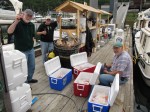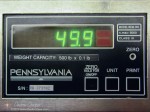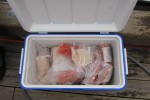So you catch your limit, what do you do with all of that fish? With halibut priced at more than $20 a pound down south it is worth the effort to get the fish home. Besides, there is nothing like a grilled salmon dinner to remind you of fishing in Alaska many months later.
But how do you get it home?
When processing the fish on-board we fillet and vacuum pack the fish each day. Two small vacuum sealers are on-board. The bags for these little devices are not cheap, but they are very effective in preserving the quality of the fish. It is a well practiced assembly line… Fish processing on the back deck, fillets carefully trimmed and divided in the galley… A vacuum packing team running the sealers and labeling each package. Good fillets packaged separately, other packs of small pieces and tails that can be used for salmon tacos and other recipes that call for chunked fish.
The fish then goes right into one of the freezers on-board, loosely stacked to allow air circulation around each package and quick freezing. Over the next few days the freezing process is checked and packages rotated, once well frozen the freezer can be tightly packed to save space.
You can buy fish boxes at most sporting goods stores and large markets in Alaska, but for the same price you can do better… Our usual solution is to buy an inexpensive cooler. A basic 48-quart plastic cooler will run around $25 in the Juneau Fred Meyer or Costco. It can also be brought up in checked luggage filled with food and treats for the trip, as long as you consider the 50lb weight limit and $25 bag fee on Alaska Airlines. Purchased before the voyage it will be used to cool drinks or veggies as we travel. Perhaps it gets filled with glacier ice for drinks and cocktails. After the trip it can be used again, unlike a disposable fish box.At the end of the trip all of the coolers are laid out on the deck to receive the fish as we unpack the freezers. A share of fish is divided out to each party headed home. As salmon and halibut packets get sorted we try to give everyone an equal share. Preferences may result in trades, some folks prefer halibut over king salmon. We try to insure everyone gets a selection of tails and pieces bags as well as fine fillets. In all of our trips we have always filled the coolers. It may take a little more effort in fishing during the last day or two, but we have sent the coolers home full.
A 48 quart cooler will hold a bit over 40 pounds of frozen fish. As the weight limit is 50 pounds on Alaska Airlines, this works out pretty well. The fish must be well frozen to make the journey without thawing. Airline rules permit a limited amount of dry ice, but there are rules and you must declare and label the package. Even on a long run to Kona with hot summer airport ramps, I have generally only found some slight thawing in the corners of the cooler. Those bits of fish get used first.The cooler can be sealed with several wraps of duct tape around the body of the cooler. This creates a heavy strap that seems to survive airline luggage handlers. Look around you in line at the airport, this is the standard accepted method of closing a cooler for travel. Check for the “Keep Frozen” tags at the Alaska check-in counter and stick a couple on the cooler. Some Alaska airport facilities, including SeaTac, have freezer space if your bag misses a connection. No guarantee, but it might save your fish. I suggest reading the Alaska Airlines policy on perishables.
If staying in town for a night or two it is necessary to get the cooler into a freezer. Many of the hotels in the fishing ports have freezers. You will find them listed right next to the other amenities like swimming pools and free WiFi. As sports fishermen that make up the summer trade require freezer service as a basic feature in choosing a hotel, your question should be no surprise to the staff. Check the hotel website or call the desk to insure freezer space is available before booking. It may cost a few dollars per night for the service, pay it, the fish is worth far more. These commercial freezers will also help insure your fish is hard frozen before loading on the plane.Using these methods we have never lost our fish on the return flight. I suppose there is always a first time, a disaster will happen one day. So far, we have had good luck, even with the long flight from Juneau to Kona.



